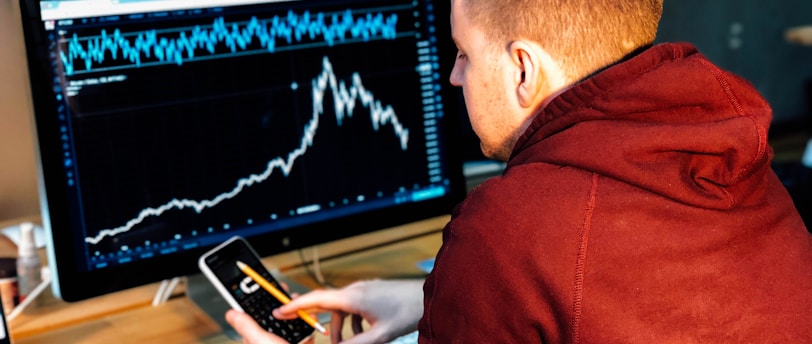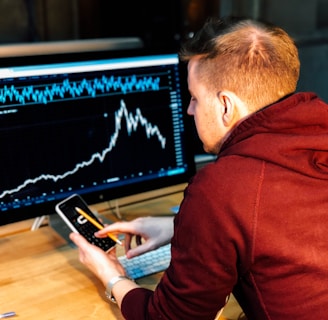Forex Trading Tips for beginners: A Strong Foundation for Long-Term Achievement
Start your forex trading journey with confidence. Discover beginner friendly tips on strategy, risk control, trading psychology, to build long-term success.
FOREX
Ayushi
7/24/2025


The forex trading market is the largest and most liquid financial marketplace in the world. More than $7 trillion of currencies change hands each day. For new investors, that's exciting—yet confusing and perilous. Gaining success with forex trading has nothing to do with luck or high speed. It has everything to do with preparation, self-discipline, and learning to handle risk.
This blog posts tried, tested advice that assists novice traders with establishing a solid foundation in the forex market. Whether part-time trading or considering forex as a career, these steps can assist you in staying away from expensive errors.
1. Begin with Education and a Risk-Free Demo Account
Why education is important
Most beginners overlook how intricate forex trading is. If traders don't grasp foundational terms such as pips, lots, bid/ask spread, or leverage, they can do irreparable damage with their trades. Prior to risking actual cash, concentrate on mastering:
1.How the forex market operates (24/5 hours, currency pairs, sessions)
2.Order types (market, limit, stop-loss, trailing stop)
3.Technical vs. fundamental analysis
4.Economic indicators (GDP, interest rates, inflation reports)
5.Good free sources include BabyPips, Investopedia, and the main broker education centers.
Why a demo account is useful
When you know the fundamentals, get a demo account from a good broker. This is your training ground. Spend this time doing:
Learn how price charts work
Practice putting on orders
Back-test your strategy in real market conditions—without risking capital
Don't play around with the demo as if it were a game. The idea is to mimic real choices, not bet on imaginary money.
2. Construct a Trading Plan and Stick to It Sacredly
A forex trading plan describes where and when you will trade. It's your playbook. Good traders use planning, not emotions.
Your plan must have:
1.Your selected currency pairs (such as EUR/USD, USD/JPY)
2.Times of day you will trade (coordinate with major sessions)
3.Risk per trade (typically 1–2% of your capital)
4.Entry and exit rules (technical or fundamental setups)
5.Your stop-loss and take-profit reasoning
6.Review and journal schedule (frequency you look at trades)
Example: You trade EUR/USD between 1:00 pm – 4:00 pm IST with moving average crossovers with a 1:2 risk-reward ratio. You record each trade in Excel or Notion to monitor success.
3. Practice Good Risk Management from Day One
Risk management is what gets you paid. Even good traders have losing trades—it's how you deal with those trades that count.
Key rules to abide by:
Never risk more than 1–2% of your capital per trade
If your account is ₹1,00,000, risk per trade must be ₹1,000–₹2,000 max.
Always place a stop-loss order
A stop-loss prevents losses from increasing unnecessarily. New traders usually do not do this and blow accounts on one losing trade.
Maintain leverage low
Steer clear of high-leverage accounts (e.g., 100:1) until you gain experience. Leverage can convert small errors into large losses.
Position sizing is important
Use lot calculators to ensure your position size matches your risk level.
4. Avoid Emotional Trading and Psychological Traps
Trading is more psychological than technical. Even if your strategy is solid, emotions like fear, greed, or revenge can ruin results.
Watch for these traps:
Overtrading: Trading too frequently leads to fatigue, mistakes, and excessive fees.
Revenge trading: Trying to make up for losses by placing larger trades quickly.
Fear of missing out (FOMO): Entering trades late once the move has begun.
How to remain balanced:
Take a break after losses
Utilize checklists prior to entering trades
Pre-plan your responses to various outcomes
Always keep in mind: discipline overrules emotion every time.
5. Combine Technical and Fundamental Analysis
Successful traders don't use only one method of analysis. Technical analysis employs charts, patterns, and indicators such as RSI, MACD, or Bollinger Bands to predict price action.
Fundamental analysis examines economic news, central bank actions, inflation figures, and GDP releases to gauge currency strength.
For example: A technical breakout of GBP/USD could be backed up by a positive UK jobs figure. Putting both together reinforces your belief in the trade.
Tip: Use an economic calendar (such as Forexfactory or Trading Economics) to follow significant news events.
6. Keep a Trading Journal and Reframe Your Trades
Your forex trading journal is your own mentor.
Log each trade with:
Date and time
Currency pair
Entry and exit points
Stop-loss and take-profit
Result (in ₹ or pips)
Mistakes or lessons
Review each 10–20 trades:
Which strategies are good
Which setups fail frequently
Emotional patterns in losses or gains
This one tiny habit learns you faster than watching YouTube videos or copying someone.
7. Select the Proper Broker and Platform
Not all brokers suit beginners. Before you fund your account, verify:
Regulation: Look for brokers regulated by SEBI (India), FCA (UK), or ASIC (Australia).
Spreads and fees: Lower spreads reduce your cost of trading.
Platform: MetaTrader 4 (MT4), MetaTrader 5 (MT5), or cTrader are widely used.
Customer support: You’ll need help occasionally—make sure it's fast and responsive.
Deposit/withdrawal process: Avoid platforms with hidden fees or slow fund access.
Demo accounts are a great way to test brokers before committing.
8. Be Patient and Manage Expectations
Forex trading is not a get-rich-quick proposition. Ninety percent of newcomers fail because they:
Want quick profits
Scale lot after one win
Disregard stop-losses after one loss
Have this attitude:
Try to learn, rather than just make.
Realize losing trades come with the territory.
Compounding steady growth over time trumps one lucky trade.
Example: Target a 3–5% monthly return with good risk management. After 12 months, this compounds significantly.
9. Top 10 Beginner Mistakes to Avoid
Mistakes:
Trading without a strategy
Results in emotional trades and unpredictable results
Applying too much leverage
Boosts risk exposure and potential for significant losses
Not respecting stop-loss orders
Can destroy accounts with one misplaced step
Risking too much per trade
Does not allow long-term existence within the market
Overtrading
Dilutes concentration and raises possibilities for loss
Revenge trading
Results in emotional trades and huge blunders
Trading blindly during news
Irregular price fluctuations can bring on losses rapidly
Blindly copying others
What others do may not be suitable for your own style
Not using journals
Slows down learning and self-improvement
Seeking overnight success
Causes frustration and disillusionment
Conclusion:
Forex trading can be lucrative if done with the right attitude and tools. As a novice, your objectives should be capital preservation, strategy formation, and skill development.
Here's what to do next:
Constantly learn from credible sources.
Practice in a practice account until your winning percentage becomes stable.
Begin small in real money.
Stick with your trade plan and control risk closely.
Monitor, review, and adjust.
Don't take shortcuts. The traders that remain disciplined, thoughtful, and realistic are the ones that perform well in the long run.
About Company


